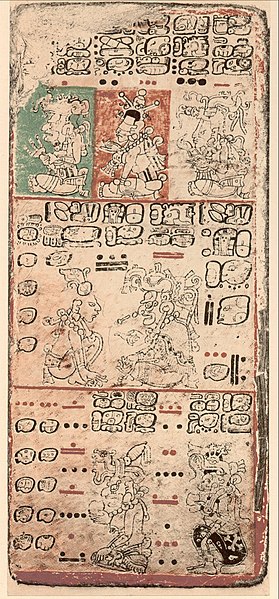Only three Maya “books” or codices survived the Spanish conquest of Yucatan

A page from the Dresden Codex showing images from Maya civilization. ~ from Wikipedia commons–this image is in the public domain because its copyright has expired.
The Maya, an indigenous people of the Yucatan Peninsula in Mexico plus Guatemala, Belize, and Honduras, made folding books written on the inside bark of certain types of fig trees.
Called “codices” (codex in the singular), many were destroyed by the Spanish conquistadors and priests.
For example, in July of 1562, Bishop Diego de Landa ordered the destruction of all of the codices in the state of Yucatan.
De Landa also destroyed a Maya temple in Izamal, using the stones from the temple to make an elegant convent, which we visit in the Yucatan Travel Movie. Izamal is a gorgeous colonial city only about an hour and a half drive from Chichen Itza and well worth the visit.
The three codices that survived the Spanish conquest are named by the location of the museum where they presently reside.
- The Dresden Codex, is housed in Germany, is made of 74 pages (39 leaves written on both sides), contains descriptions of rituals and astrological information on eclipses of the sun and moon as well as the cycles of Venus.
- To my way of thinking, the Paris Codex, in France, is the most interesting since it deals with the Maya calendar and includes prophecies for various tuns and Katuns.
- The Madrid Codex is the longest at 112 pages and is housed in Spain. Researchers believe it was put together quickly after the Spanish conquest.
Occasionally, hopelessly decayed codices are found in Maya ruins:
Given the rarity and importance of these books, rumors of finding new ones often develop interest. Archaeological excavations of Maya sites have turned up a number of rectangular lumps of plaster and paint flakes, most commonly in elite tombs. These lumps are the remains of codices where all the organic material has rotted away. A few of the more coherent of these lumps have been preserved, with the slim hope that some technique to be developed by future generations of archaeologists may be able to recover some information from these remains of ancient pages.